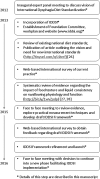Development of International Terminology and Definitions for Texture-Modified Foods and Thickened Fluids Used in Dysphagia Management: The IDDSI Framework
- PMID: 27913916
- PMCID: PMC5380696
- DOI: 10.1007/s00455-016-9758-y
Development of International Terminology and Definitions for Texture-Modified Foods and Thickened Fluids Used in Dysphagia Management: The IDDSI Framework
Abstract
Dysphagia is estimated to affect ~8% of the world's population (~590 million people). Texture-modified foods and thickened drinks are commonly used to reduce the risks of choking and aspiration. The International Dysphagia Diet Standardisation Initiative (IDDSI) was founded with the goal of developing globally standardized terminology and definitions for texture-modified foods and liquids applicable to individuals with dysphagia of all ages, in all care settings, and all cultures. A multi-professional volunteer committee developed a dysphagia diet framework through systematic review and stakeholder consultation. First, a survey of existing national terminologies and current practice was conducted, receiving 2050 responses from 33 countries. Respondents included individuals with dysphagia; their caregivers; organizations supporting individuals with dysphagia; healthcare professionals; food service providers; researchers; and industry. The results revealed common use of 3-4 levels of food texture (54 different names) and ≥3 levels of liquid thickness (27 different names). Substantial support was expressed for international standardization. Next, a systematic review regarding the impact of food texture and liquid consistency on swallowing was completed. A meeting was then convened to review data from previous phases, and develop a draft framework. A further international stakeholder survey sought feedback to guide framework refinement; 3190 responses were received from 57 countries. The IDDSI Framework (released in November, 2015) involves a continuum of 8 levels (0-7) identified by numbers, text labels, color codes, definitions, and measurement methods. The IDDSI Framework is recommended for implementation throughout the world.
Keywords: Deglutition; Deglutition disorders; Dysphagia diet; Food and fluid standards; Swallowing; Texture-modified food; Thickened fluid.
Conflict of interest statement
IDDSI and the authors have no conflicts of interest to disclose
Figures








Comment in
-
Letter to the Editor.Dysphagia. 2019 Jun;34(3):415. doi: 10.1007/s00455-018-9952-1. Epub 2018 Oct 17. Dysphagia. 2019. PMID: 30334094 No abstract available.
References
-
- Castellvi MTC. Theories of terminology. Terminology. 2003;9:163–199. doi: 10.1075/term.9.2.03cab. - DOI
Publication types
MeSH terms
Grants and funding
LinkOut - more resources
Full Text Sources
Other Literature Sources
Medical

